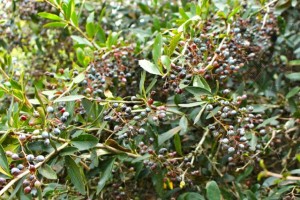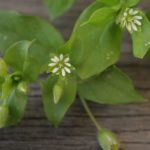Barberry Berberis glaucocarpa made its first impression on me as a painful thorn in the middle of my foot and the long needle used to get it out, when I was about 8 years old playing barefoot near a hedge on our farm at Kakariki in the Wairarapa. It’s been many decades since then and I’ve recently discovered that besides being a prickly menace, it is actually a very medicinal plant!
I kept an article that appeared in the Coast and Country paper entitled “Barberry – that blasted hedge out the back has special qualities” by Karina Hilterman a herbalist. I was intrigued by all the good things she said about it. This has given me a new appreciation for this maligned plant which was brought here to New Zealand from Europe as a stock proof hedge. It is actually native to the Himalayas – perhaps that’s why it is so tough!
It is a woody, evergreen or semi-deciduous shrub that grows 2-3 metres high, and is known for its sharp spines. The spines grow out from the branches singly or divided into groups of three where the oval to egg-shaped leaves grow. The leaves have small spines as well. Bunches of small yellow flowers appear during October and November followed by blue/purple berries that have a whitish
coating or bloom. Birds disperse the seeds enabling barberry to spread easily. Because of this it is subject to Plant Pest Management strategies in several regions.
It likes to grow in waste places, reverting hill country where it helps control erosion if allowed, scrub and forest margins, all these places have empty niches once occupied by native plants and serve to cover and protect the land. They also grow around old house sites and were planted as hedges around gardens, in the case of our long time ago home. Huge old shrubs with arching branching are shelter for stock and birdlife.
The name Berberis is from Arabic for barberry and glaucocarpa (Lat.) = fruit with a bloom. There are two other species in NZ Darwin’s barberry (Berberis darwinii), which is taller growing up to 4 metres high and is evergreen. Its flowers are deep orange growing in long clusters and the leaves look like holly leaves growing in groups of 3 to 5. Coming out of the same place are 5 pronged sharp spines.It flowers Jan-Dec growing in Southern NI and from Central Canterbury to Stewart Island. Then there is Berberis vulgaris, a deciduous, (loses its leaves) shrub up to 2m, with oblong red fruit growing in Canterbury and Otago, around old homesteads.
Now to it’s medicinal, nutritional qualities.
To start with the flowers and young spring leaves are edible, tasting a little sour, a good thing to enhance a detox after winter. I will be trying them next spring.
The most medicinal parts are the bark of the roots and stems which are bright yellow, the color of Berberine, a healing alkaloid the plant contains. It has several other alkaloids including tannins, malic
acid and citric acid giving the flowers, leaves and fruit the slightly sour taste. These alkaloids have proven anti-cancer properties.
It is a broad spectrum antibiotic – helps with urinary tract infections and its bitter taste stimulates digestion and bile flow, improves liver function and that in turn helps skin conditions like eczema, acne and psoriasis.
Its specific speciality treatment though is for the gall bladder – inflammation and gall stones. The part that had me interested is that it increases blood flow to the spleen (site of my former autoimmune disease), white blood cell count and strengthens the immune system. It is also used for fungal and respiratory infections.
But how to take it you might ask?
You can make a tincture by digging some roots, scrub off the dirt and shave off the bark – I just cut up the roots and put them in a jar and then covered that with vodka. Probably best to dry the roots first. Shake the jar every few days and after 6 weeks strain the remedy. The dose Karen recommends is 1-3mls 3 times per day.
You can also prepare it in water called a decoction. Use 1 tsp of bark to 1 cup of water. Bring to the boil, simmer for 10-15 minutes, cool and strain. Drink the liquid 3 times per day adding honey to “help the medicine go down”. Traditionally barberry was used to treat fevers, cholera and typhus.
It is also a dye plant – the yellow shade depending on the whether the mordant was lye or alum.
I visited our boundary hedge and ate some of the berries which I found surprisingly nice to eat, no big stones and a little tart.
I had the idea to create a bliss ball where the tastiness would make them less sweet.
Barberry, Peach Bliss Balls
3/4 almonds, 1/4 cup sunflower seeds
1/2 barberry berries – I soaked them as they were a bit shriveled up.
3/4 cup dates soaked
1/4 cup dried peaches
Pinch salt
Pinch cinnamon
1 T carob powder
1/4 coconut
Process the nuts and seeds until reduced to crumbs in a food processor.
Add the fruit, salt, carob, coconut and spices and mix until it all binds together. Roll into balls and coat with coconut.
The same evening I made a marrow, tomato, onion, garlic, turmeric, cumin stir fry and thought the barberries would go well so added them once it was on my plate and I really enjoyed it.
Spare a plant or two you never know when you may need Barberry.
Special thanks to Karen Hilterman, medical herbalist.









Great stuff. Glad to hear about the Barberry. i used to eat the small leaves of the hedge at home as a kid. Its great for bees!! :o) And we bought some Darwins barberry back from the Catlins near Dunedin – beautiful bright orange flowers. have a wee cutting here if you want one Julia. Its not real popular with locals down there. Understandable. but being beekeepers….we couldnt resist hahaha.
Dont suppose you know any herbal uses for Matagouri? We have some of that too from Otago – another good bee plant.
best xmas wishes,
Crystal Epps